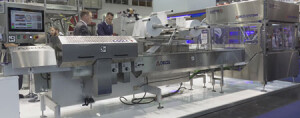Food firms must seize the Brexit opportunity
 While the use of robotics and automation in the UK food and drink industry has been steadily growing over the past decade, Britain is still lagging behind many of its international counterparts. As the lowest G7 nation, UK sits 22nd in the world robot league table with just 71 robots per 10,000 workers, behind nations such as Slovenia (137), Sweden (223), and South Korea (631). This could be about to change, however, as an unlikely source is set to herald a long-awaited robot revolution in food production, as Tony McDonald, Sales and Marketing Director of Ilapak UK, explains.
While the use of robotics and automation in the UK food and drink industry has been steadily growing over the past decade, Britain is still lagging behind many of its international counterparts. As the lowest G7 nation, UK sits 22nd in the world robot league table with just 71 robots per 10,000 workers, behind nations such as Slovenia (137), Sweden (223), and South Korea (631). This could be about to change, however, as an unlikely source is set to herald a long-awaited robot revolution in food production, as Tony McDonald, Sales and Marketing Director of Ilapak UK, explains.
One of the main barriers to greater uptake of automation, particularly amongst SMEs, is the cost of unskilled labour versus investment in robotics technology. Thanks to the EU’s free movement of workers, Britain’s food and drink industry has benefitted from cheap labour for a number of years – in fact, it employs the highest share of EU migrant workers (30 per cent) compared with any other UK sector, employing around one fifth of the two million EU nationals working in Britain. This figure is at its highest on fruit and vegetable farms, where 99 per cent of workers come from Eastern Europe.
But Brexit is set to change the labour landscape in just a few short years. The Food and Drink Federation (FDF) reported that 47 per cent of companies in Britain’s food supply chain said their EU workers were considering their future as a direct result of the June 2016 Brexit vote. On farms the impact is starker still – according to the National Farmers’ Union, in the crucial harvest month of September 2017, 29 per cent of roles went unfilled, the first shortfall since records began back in 2014.
Brexit, combined with a skills shortage brought about an ageing domestic workforce and a lack of British young people coming into the industry – not to mention the 2020 deadline for the new National Minimum Wage – is giving the UK’s food and drink businesses a staffing dilemma. Faced with an impending lack of cheap labour, many are turning to robots to fill the gap.
The perfect employee
The deployment of robotics technology – and investment in plant automation – can revolutionise how food factories operate, increasing efficiency in all areas of the production process. Producing more items at a faster rate and at a higher level of quality, robots, in place of humans, get the job done. Not only that, a robot will never get sick, take a holiday, need a break, or even get bored.
And it can cope with extreme temperatures, as well as unsafe or unsanitary working conditions. Using automation for repetitive or dangerous tasks protects the remaining workforce, leaving employees free to be upskilled and take on safer and more rewarding roles. Far from replacing all human employees, robots can actually help to increase staff retention levels.
An end to foreign objects
As well as speeding up the production process and improving job satisfaction among human employees, the use of robots can also help to reduce contamination; a key target for any food business. A lot of food manufacturers have been running flow wrappers for years, but use staff to manually load them. They might have a belt with a high volume of products along it and four or five people on each flow wrapper picking up the products and feeding the machine.
Ilapak has introduced robots to stack products and organise them in batches of two, three or four, then use a multi-belt system to feed them into the machine. Within that process servo–drive belts can be programmed to split the products up into exactly what is required. Robots can also be used after flow wrapping to stack and pack a product before placing the packs into retail trays. Removing the human element from the process removes the risk of contamination, which in turn helps to extend a product’s shelf life.
 Waste not, want not
Waste not, want not
With contamination such a concern for food producers, cleanliness and hygiene is a key driver in any operation. One automated process which has huge potential in maintaining high levels of cleanliness and is being adopted by a growing number of producers – often working alongside vacuuming – is gas flushing. This procedure involves the replacement of oxygen with carbon dioxide and nitrogen to help keep products free from contamination and fresher for longer.
Gas flushing extends the shelf life of some products from one week to as long as six months. Not only does this reduce wastage amongst consumers, the lack of contamination during the production process keeps operational waste down, too. Given the UK’s continuing battle against food waste, this solution is a win-win, benefitting both food producers and the wider society.
Cut costs, not corners
For some food producers, such as craft bakeries or breweries, the lack of automation is part of their USP. But for the vast majority, a system which can produce thousands of identical, high quality items each hour not only cuts down labour and energy costs, it also increases brand reputation and can provide the ability to flex at short notice as consumer demand requires, which can in turn lead to increased orders.
When assessing a client’s suitability for automation and conducting a cost-benefit analysis, we consider each project on its individual needs. If a company has two or three people running the packing operations during the night using L Sealers, we look at the number of units being produced. If the company is running off 5,000 products a day, it makes better commercial sense to introduce a system such as Ilapak’s Smart HFFS entry level flow wrapping system. For higher value products, it may be cost effective to switch to automation at 3,000 units a day, but the average is around 5,000. As a comparison, a machine can produce 3,000 units an hour.
4.0 and beyond
In today’s increasingly connected digital world, the biggest trend in robots and automation is undoubtedly Industry 4.0. In 2012, there were 5.5 billion connected devices (equal to the amount of people on the planet) – today there are 50 billion. Proof, if it were needed, of the power of the Internet of Things. With production processes and equipment now able to be remotely monitored and controlled by the cloud, managers have more data and greater control over their operations than ever before.
Smart systems are able to auto-correct faults, predict maintenance and even help managers spot patterns and trends. Such optimised production lines are reducing downtime and decreasing operational costs, which is in turn leading to increased productivity.
As the UK’s largest manufacturing sector, contributing £28.8bn to the UK’s GDP, the food and drink industry is likely to be hit hard by Brexit. But perhaps the unsettled few years ahead can be tempered by investment in reliable, efficient robotic technology that can help to increase productivity and profits. For investors in automation, Brexit is not a threat – it’s an opportunity.
Visit the Ilapak website for more information















